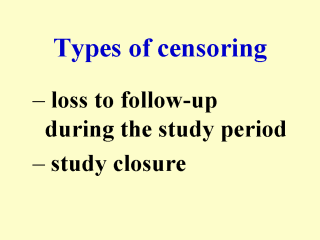| front |1 |2 |3 |4 |5 |6 |7 |8 |9 |10 |11 |12 |13 |14 |15 |16 |17 |18 |19 |20 |21 |22 |23 |24 |25 |26 |27 |28 |29 |30 |review |
 |
In medical studies
censoring is common and usually need be handled by survival analysis techniques. There are
two major sources of censoring: (1) A patient is lost to follow-up. It is known that the patient is alive at the last contact, but his subsequent survival status is not known. Time to last contact will be taken as censoring time. (2) A clinical trial or an epidemiological study is closed after a fixed study period. Some of the patients/subjects are alive at the time of study closure. Time to study closure will be taken as censoring time. Although the exact time of the outcome event is not known, the fact that it does not precede the censoring time is a piece of useful information. Survival analysis techniques utilise this information. |